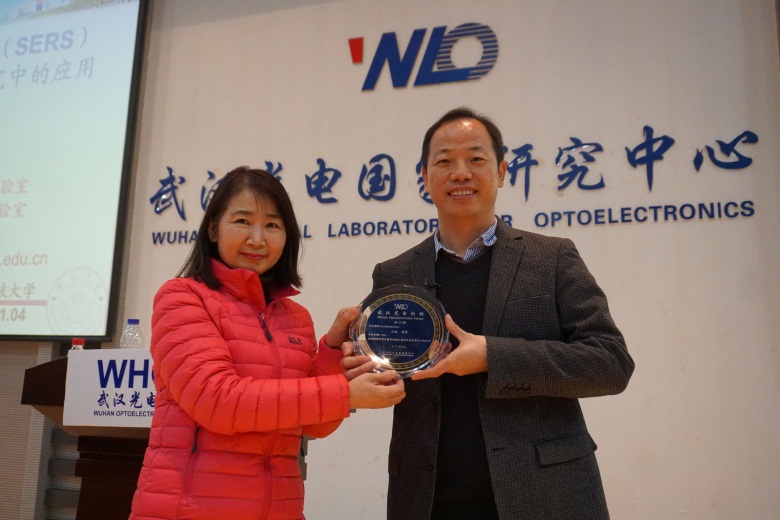WUHAN, China (January 4, 2019) - Wuhan Optoelectronics Forum No. 150 was successfully held in Auditorium A101 at Wuhan National Laboratory for Optoelectronics (WNLO) in the afternoon of January 4. Prof. Ren Bin from Xiamen University delivered an exciting talk entitled Application of Surface Enhanced Raman Spectroscopy in Cell Biology and Electrochemistry. Dr. Ping Wang, from WNLO chaired the forum. Prof. Dan Zhu, Deputy Director of WNLO, awarded Prof. Ren Bin the forum medal.
Surface-nhanced Raman Spectroscopy (SERS) is a promising technique, which utilizes nanostructures such as Ag and Au to enhance the Raman signal of molecules adsorbed on the surface of nanostructures and obtain the fingerprint vibrational information of samples with an ultra-high surface sensitivity. However, due to the complexity of biological systems and the extremely complex interaction between light, nanomaterial surface and biological system, the reliability of SERS is relatively poor, which also restricts its wide application in the field of biomedicine. This report will discuss the reliability of SERS in biological detection, as well as the opportunities and challenges. In order to expand the application of Raman spectroscopy in the characterization of electrochemical dynamic reaction processes, an electrochemical microscope on the basis of electrochemical surface-enhanced Raman spectroscopy (SERS) technology was established. The local electrochemical current of the molecule on the electrode surface could be reconstructed by the change of Raman signal intensity, and the local electrochemical information could be obtained during the process of electrochemical reaction.
Professor Ren Bin received his bachelor's degree and doctor's degree from the Department of Chemistry, Xiamen University in 1992 and 1998, respectively. He is currently the Vice Dean of the College of Chemistry and Chemical Engineering, Xiamen University, Vice Director of the State Key Laboratory of Physical Chemistry of Solid Surfaces and Associate Editor of Analytical Chemistry, American Chemical Society. He is mainly engaged in the development of Tip-enhanced Raman spectroscopy (TERS), surface-enhanced Raman spectroscopy (SERS), new methods of nanochemistry and spectroelectrochemistry, instrumentation and their applications in surface, interface processes and cell and biological systems. He has been supported by key projects of scientific instruments of NSFC, as well as projects of major instruments and equipment development and major scientific research projects of the Ministry of Science and Technology. He has published more than 200 SCI papers, including Nature Nanotechnol., Nature Commun., JACS, Angew. Chem., Chem. Rev., Chem. Soc. Rev., with more than 14,000 citations. In 2002-2003, he was funded by Alexadner von Humboldt Foundation to work at Fritz-Haber Institute in Germany. In 2008, he was awarded the National Outstanding Youth Science Fund. In 2016, he was selected as the second batch of national "ten thousand people plan" and the Changjiang Scholar professor of the Ministry of Education.

